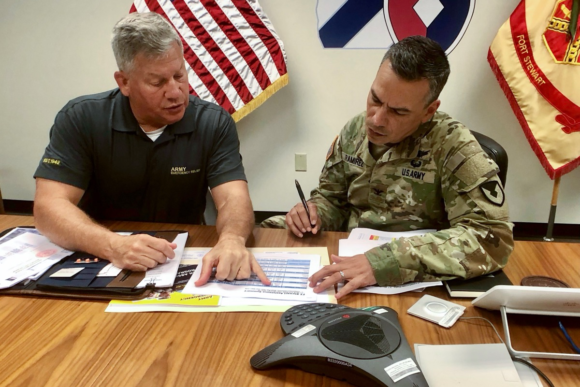The Defense Finance and Accounting Service (DFAS) handles a variety of financial activities for the Department of Defense (DoD). For military members and retirees, it’s the department that issues pay and retirement.
The organization also handles debts accrued by former service members through the DFAS Debt and Claims Management Office.
After retiring or separating from the military, learning that you owe the military money is often jarring. You might wonder where the DFAS debt came from, how you can make a DFAS debt payment, or if there is DFAS debt forgiveness.
Additionally, learning about the Defense Finance and Accounting Service forms you need to complete to report erroneous debts is a must if you’re contesting the debt.
Fortunately, settling or correcting a military debt doesn’t have to be difficult. If you’re dealing with an account with DFAS in Debt and Claims, here’s what you need to know.
What is DFAS in Debt and Claims?
According to the DFAS website, the Debt and Claims Department oversees the collection and settlement of debts owed to the DoD by former military members, former civilian employees of the DoD, and specific other individuals. Essentially, the Debt and Claims Office handles any accounts that owe money to the military.
Receiving a DFAS Debt Notification Letter
A DFAS debt notification letter is a formal communication from DFAS that’s delivered by mail. It outlines any amounts owed based on DFAS records. Additionally, it contains details about repayment, including how to submit payments directly to DFAS.
If you receive a DFAS debt notification letter, review it carefully. If you have doubts about its authenticity, contact DFAS directly. Don’t use any phone numbers listed on the letter if you aren’t sure it’s real. Instead, call a known DFAS Debt and Claims Department number, such as 866-912-6488, to confirm its authenticity.
Why You May Have DFAS Debt
Usually, DFAS debt occurs due to specific situations. According to the out-of-service debt DFAS webpage, overpayments are a potential reason for the debts. For instance, if your military or retirement pay from the DoD exceeds the amount you were or are eligible to receive, that creates a debt. The amount above and beyond what you were owed needs repaying to correct the discrepancy.
Erroneous payments are another cited cause of DFAS debt. With these, an entire payment was provided to you that shouldn’t have occurred. As a result, that whole payment amount creates a debt that needs repaying.
In some cases, the use of DoD facilities or services may trigger debts. Additionally, if you owed money prior to separation or retirement that wasn’t repaid before your separation, you end up with a DFAS debt.

Check your VA Home Loan eligibility and get personalized rates. Answer a few questions and we'll connect you with a trusted VA lender to answer any questions you have about the VA loan program.
How to Check Your DFAS Debt
There are several ways to check your DFAS debt to review what you owe. Typically, the details relating to your debt are presented in a DFAS debt notification letter. Along with the total, it lists the reason for the associated debt, making it a good starting point.
Additionally, you can check your account status online through the DFAS website. This approach works for out-of-service debts. Once you use the tool, you can view your account balance, payment history, and the status of your account.
The information is updated daily, so there’s a slight reporting delay. For example, if you submit a payment today, that information doesn’t show in the status tool until the next day.
Finally, you can call DFAS at 866-912-6488 for more information. Assistance by phone is available Monday through Friday from 7:00 am to 4:00 pm EST/EDT.
What Happens If You Have Debt in the Military?
Having a debt in the military can come with a variety of consequences. Involuntary repayment options are available to the DoD, including wage garnishments that allow them to collect what’s owed. Additionally, certain funds received from the federal government are potentially subject to seizure until the debt is repaid.
As with any debt, harm to your credit report and score occurs if the DoD or DFAS reports the debt as delinquent. Negative remarks not only bring down your score but also make you a less attractive borrower to other lenders.
As a result, getting new credit is potentially tricky. Further, you may not qualify for interest rate reductions with your current lenders.
What to Do If You Disagree with a DFAS Debt
If you disagree with a DFAS debt, you can request a cursory review. According to the DFAS website, you need to begin the process within 30 days of the letter’s original issue date.
Essentially, by formally disputing the debt with DFAS, you’re requesting that they review your account to check for accuracy. Usually, the goal with disputes is to correct amounts owed that aren’t legitimate. If successful, DFAS removes the debt from your account.
How to Request a Remission or Waiver
Remissions and waivers are options for addressing a DFAS debt. Remissions request the cancelation of all or a portion of a debt and are applicable to active duty debts. DFAS doesn’t directly process remission requests. Instead, you’ll need to contact your service directly for application information and instructions.
Waivers ask the DoD to relinquish its debt claim against you and can address debts relating to erroneous debt or allowance payments. Typically, you complete DD Form 2789 and submit it to DFAS for consideration.
If you need to request a waiver, you can also learn more through the protest submission online portal. The Waiver of Indebtedness Submissions category contains helpful information that’s worth reviewing.
It’s critical to note that DFAS can’t process waivers associated with disputed debts. As a result, you need to choose either to pursue a waiver or to dispute the debt, as doing both simultaneously isn’t an option.
How to Dispute a Debt with DFAS
If you want to dispute a DFAS debt, you’ll need to submit a dispute petition. You can submit your protest online. Choose the proper category from the available options and review the frequently asked questions links for some additional details.
For military pay and allowance-related debts, choose the Military Pay & Allowance Debts category from the dropdown to narrow the results in the list. You can then select a subcategory or skim the presented topics to find the one you need.
You can also check Dispute Debt – Other for additional options if you can’t find a match.
How to Pay Your DFAS Debt
There are several ways to pay your DFAS debt. For non-delinquent debts, you can use one of the available repayment options.
First, you have the ability to send in a lump sum payment to cover all of what’s owed. Using the Pay.gov portal is a simple way to submit a lump sum payment online. You can also use the payDFAS app by scanning the QR code on your notification and scanning it again once you install the app and follow the instructions.
Checks or money orders are also an option for lump sum payments. With these, you can send it to the mailing address listed on your debt notification.
Alternatively, you can request an installment plan to pay off the debt. You’ll need to complete specific Defense Finance and Accounting Service forms. That includes the following:
- DFAS Reduced Installment Application
- Voluntary Repayment Agreement and Financial Hardship Application
Once you complete the paperwork, follow the submission instructions to submit your request. Additionally, make the installment payments you proposed on the documents while your request is processing. That helps you avoid collection efforts from outside companies that DFAS uses to address delinquencies.
If a debt ends up delinquent, other processes begin. That can include involuntary payments – essentially wage garnishments – along with the seizure of payments from the federal government, such as tax refunds, Social Security payments, and more.
Debt Relief Options and Programs for the Military
When you’re dealing with money owed to the DFAS Debt and Claims department, many people want to explore military debt forgiveness options to handle what’s owed. In some cases, you can pursue waivers or remissions as described above, as those functionally act as debt forgiveness or elimination.
Generally, remission is closer to military debt forgiveness as personal or financial hardship is a potential cause for pursuing it, even if the debt is legitimate. However, since waivers focus on the person with the debt not being at fault – as it is only available for erroneous payments – it can also qualify.
For individuals who are currently pursuing higher education after leaving military service, you also have the option to request a student deferment if you have education-related DFAS debt. You can review the DFAS student deferment information packet for additional details.
Otherwise, you can explore other types of financial assistance that focus on current and former military members. Military OneSource has free financial counseling and can assist with debt management or consolidation to make repaying DFAS more manageable.
Speaking with a reputable, certified credit counseling agency is another similar option.
Be wary of any organization that claims it can eliminate debt for military members, veterans, and their families. Additionally, be cautious if you’re exploring debt settlement organizations. Scams are common in these arenas, so research the organization thoroughly before engaging with them in any capacity.
DFAS Debt and Claims FAQs
What Happens If I Don’t Pay DFAS Debt?
Generally, you have 30 days after the debt notice is issued to repay the amount owed before the account is considered delinquent. If there isn’t a payment within 62 days, DFAS takes other actions.
After 62 days, DFAS reports the debt to the credit bureaus, resulting in a negative comment on your credit reports. Typically, that leads to a credit score drop, and according to Experian, the negative remark can remain on your report for up to seven years.
That’s long-term harm to your ability to qualify for new credit or better interest rates on existing credit accounts.
DFAS also refers delinquent accounts to collection agencies. Once that occurs, you can end up with more negative remarks on your credit report. Additionally, at that point, you’ll have to deal with the collection agency directly instead of DFAS to make payment arrangements.
In some cases, the Treasury Offset Program (TOP) takes part in the equation. TOP helps government agencies collect debts, typically by involuntarily securing funds from other government-related payment systems.
For example, they can seize federal income tax refunds, either partially or in full, until the amount owed is covered. They can also garnish Social Security income, OPM annuity payments, and non-DoD federal salaries.
Does DFAS Automatically Deduct My Debt?
DFAS can automatically deduct your debt payments in some situations. Generally, these happen with delinquent debts, as the approach works as an alternative to more costly collection efforts.
For example, according to the DFAS website, if a military member separates with a debt and then re-enlists or is called back to duty, a salary offset may occur. In this case, the balance is referred to the person’s finance office, and an involuntary offset equal to two-thirds of their disposable net income or the total of the debt – whichever is lower – is collected automatically. The offset remains until the debt, including any interest and fees, is repaid.
For retirees receiving retirement payments from the military, an involuntary offset is also possible. Again, the involuntary payment is potentially as high as two-thirds of the person’s disposable net income, suggesting the amount owed, including interest and fees, is at least that high. The offset continues until the debt is paid in full.
Any delinquent debt owed by DoD civilians is also subject to an involuntary offset. The payment can’t exceed 15 percent of disposable pay unless the person gives written consent for a higher amount. The obligatory payments continue each pay period until the debt is fully addressed.
For non-delinquent debts, automatic DFAS deductions don’t occur. Instead, you’ll need to use one of the payment options above to either pay the amount in full or set up a payment plan.
What Is DFAS Out of Service Debt?
Out-of-service debt is money owed by a separated or retired military member, former civilian DoD employee, or certain other individuals whose association with the DoD ended. Essentially, DFAS only collects debts from people who are no longer receiving employment-related pay from the DoD, as they aren’t currently employed by the DoD or the DoD as a civilian.
In this case, retirees are considered out-of-service, even if they’re receiving retirement payments from the DoD. Since they’re no longer working for the military or as a civilian DoD employee, they’re classified as out-of-service.
Technically, the DFAS Debt and Claims Department only handles DoD out-of-service debt. They don’t manage debt collections for other agencies, including the Department of Veterans Affairs (VA), Army Corp of Engineers, or contract-related debts, for example.




About the comments on this site:
These responses are not provided or commissioned by the bank advertiser. Responses have not been reviewed, approved or otherwise endorsed by the bank advertiser. It is not the bank advertiser’s responsibility to ensure all posts and/or questions are answered.